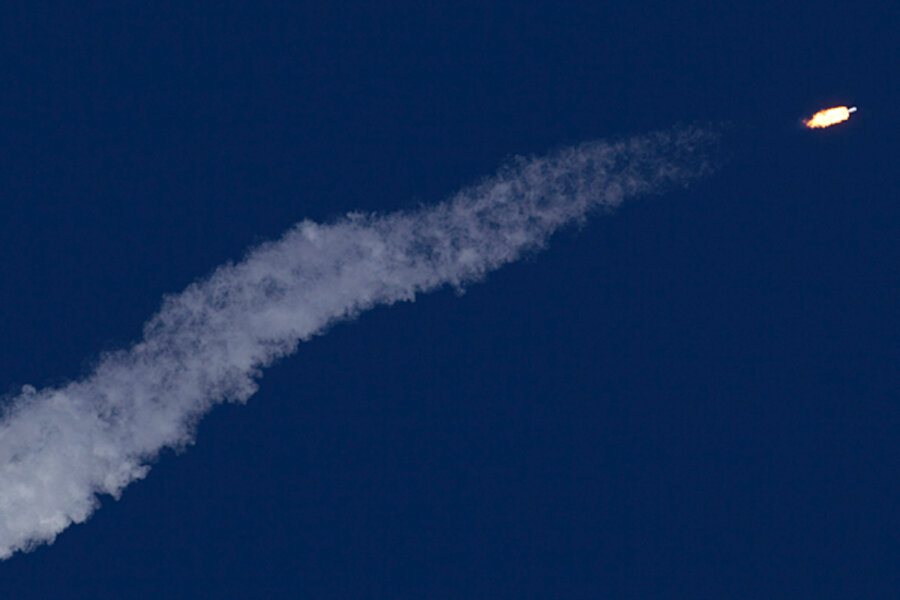'Too good to be true': SpaceX mission appears nearly flawless
Loading...
A privately financed company, SpaceX, lofted a spacecraft of its own design into orbit Wednesday and safely brought it back – a technological feat until now the province of government space programs.
The success is a major step toward expanding the role private companies play in launching people and the cargo they need to sustain them into space.
At 10:43 a.m. Eastern time, SpaceX's Falcon 9 rocket carried the company's Dragon spacecraft into orbit. Three hours and 19 minutes later, the Dragon capsule splashed down in the Pacific some 500 miles off the southern California coast, falling less than a half mile from its intended target point – for rocket scientists, a bulls-eye.
The mission is the second successful launch in a row for the Falcon 9 itself – no mean feat, according to Alan Lindenmoyer, who runs NASA's commercial crew and cargo program. He notes that over the past 20 years only half the new rockets tested succeeded on their first or second flight, while only one out of three posted back to back successes.
In a congratulatory post on Twitter, former space-shuttle program manager Wayne Hale added that "safely returning anything from orbit is harder than getting it into orbit in the first place."
NASA cheers
In a prepared statement, Sen. Kay Bailey Hutchinson (R) of Texas called the mission "an important achievement" that eventually would allow NASA to move forward on a bolder goal: "to focus its efforts on the development of a new launch system and crew-exploration vehicle to move beyond low-Earth orbit."
A preliminary reading of data from the mission indicated that everything worked perfectly, according to officials from SpaceX and NASA, which provided the company with technical assistance in developing the craft.
NASA's goal is to build a stable of commercial companies capable of providing transportation to and from the space station in low-Earth orbit. But SpaceX's goal is to provide low-cost access to space for an increasingly wide range of customers, including NASA.
"I really want us to become a true spacefaring civilization" on a path to being a multiplanet civilization, says Elon Musk, who heads the company, formally known as Space Exploration Technologies Corporation, based in Hawthorne, Calif. Reduced launch costs are widely seen as a critical step down that road.
The launch was originally scheduled for Tuesday. But technicians discovered two small cracks in the second-stage motor's exhaust nozzle. The SpaceX team was able to make the needed repairs quickly, allowing for Wednesday's launch – a day earlier than initially thought when the cracks were discovered.
Then, during an initial launch attempt Wednesday morning, computers in launch control registered an abort command with just under three minutes left in the countdown. Controllers quickly identified the problem causing what turned out to be a bogus command and prepared for a launch later in the morning.
'Too good to be true'
Still, looking back on the mission, Mr. Musk said the results "almost seem too good to be true. I'm in semi-shock."
One critical system after another – from 18 small thrusters the capsule has to control its position in space to the proper deployment of the capsule's parachutes after reentry – appear to have performed without a hitch.
The project is an outgrowth of NASA's Commercial Orbital Transportation System (COTS) program, initiated in 2006 under then-NASA Administrator Michael Griffin. SpaceX is one of two companies with NASA COTS contracts.
Wednesday's SpaceX mission was the second flight for the Falcon 9 rocket, but the first to be topped with a fully-functioning Dragon capsule. Under a $1.6 billion contract the company has with NASA to resupply the space station, it must complete at least one more mission with the capsule. If a thorough analysis of the data from this flight turns up no show stoppers, the next launch could take place as early as next summer, with the space station its destination, company and NASA officials say.





